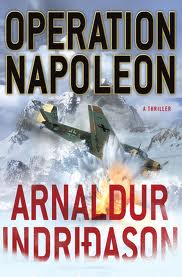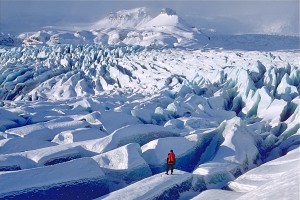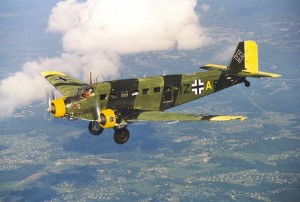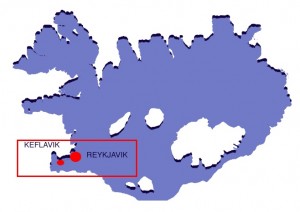Note: Indridason was WINNER of the Glass Key Award for Best Nordic Crime Novel in 2002 and 2003, and WINNER of the Gold Dagger Award from the Crime Writers’ Association in 2005.
“History is all lies – you know that and I know that. There have been so many cover-ups, so many fabrications; we’ve told the truth about lies and lied about the truth, taken out one thing and substituted another. That’s our job.” – Col. Miller, US Army
 Reading this recently translated 1999 novel by Icelandic author Arnaldur Indridason feels much like reading a movie. A stand-alone thriller of World War II and its aftermath, Operation Napoleon is not part of the author’s later, more character-based Erlendur series, with its dark themes and grim visions of human nature. This is not to say that this novel is not also full of violent behavior against innocent characters, but in this novel the villains are the Americans based in Iceland, who will stop at nothing to further America’s global interests. The “heroes” of the novel are the honest Icelanders who inadvertently run afoul of US interests.
Reading this recently translated 1999 novel by Icelandic author Arnaldur Indridason feels much like reading a movie. A stand-alone thriller of World War II and its aftermath, Operation Napoleon is not part of the author’s later, more character-based Erlendur series, with its dark themes and grim visions of human nature. This is not to say that this novel is not also full of violent behavior against innocent characters, but in this novel the villains are the Americans based in Iceland, who will stop at nothing to further America’s global interests. The “heroes” of the novel are the honest Icelanders who inadvertently run afoul of US interests.
Operating in conjunction with the controversial US Army base in Keflavik, a secret spy agency known as “Building 312,” in Washington, DC, plans to conduct a mission on Iceland’s largest glacier without the knowledge of their usually cooperative hosts, who know nothing more than a cover story about “routine training” disseminated by US intelligence. The paranoid Americans in charge of the mission will stop at nothing, including cold-blooded murder, in order to accomplish their ends.

The reader knows no more about the real reasons for this mission than do the Icelanders for most of this action-packed novel, but the reader does know that the Americans are searching for a mysterious German plane which went down on the Vatnajokull Glacier at the end of World War II, a plane which was almost recovered in 1967, before the glacier’s ice swallowed it up again. Images of the plane unexpectedly reappear in satellite photographs in 1999, over fifty years after its crash, and US intelligence now believes they may have been given a final chance to find the plane, remove all traces of it from the glacier, transport it to the US for examination, and gain immediate control of all its contents, whatever they may be.
As the action begins, two young Icelanders, training to be rescue workers on the glacier, wander from their usual path and see armed US soldiers around an old plane. Taken prisoner, they then “disappear,” and the US mission finds itself facing its first  challenges in damage control – by whatever means are necessary. Elias, one of the young men, has described what he has seen in a last-minute cell phone call to his sister Kristen, and she, a lawyer with the justice ministry, begins to ask frantic questions in an effort to find her missing brother.
challenges in damage control – by whatever means are necessary. Elias, one of the young men, has described what he has seen in a last-minute cell phone call to his sister Kristen, and she, a lawyer with the justice ministry, begins to ask frantic questions in an effort to find her missing brother.
Kristen’s own life is endangered when she becomes the prime suspect in a murder which has taken place in her apartment, and, believing that her own police and government are in league with the Americans, she seeks help from a former boyfriend who works at the Keflavik Air Base. The two set out to find Elias, in the process facing innumerable challenges from a sadistic American killer working with the US intelligence agency which is trying to find them. Scenes of torture and murder run parallel with new discoveries at the excavation site as the author connects the present with the wartime past and with the 1967 discovery of the plane on the glacier. At that time, astronaut Neil Arms trong was visiting Reykjavik, a distraction which the intelligence agency had hoped would allow them to excavate the plane before it was swallowed by the ice. In each of these sections, key information is provided to the reader, suggesting some of the reasons that this mission is considered so important that even murder can be justified by the mission’s leaders.
trong was visiting Reykjavik, a distraction which the intelligence agency had hoped would allow them to excavate the plane before it was swallowed by the ice. In each of these sections, key information is provided to the reader, suggesting some of the reasons that this mission is considered so important that even murder can be justified by the mission’s leaders.
The ending comes amidst many revelations involving the various characters and their pasts, and though all is eventually resolved, the reasons behind the mission are far-fetched. The director of the US spy agency in Building 312 actually says, cynically: “Truth and lies are nothing but a means to an end. I make no distinction between them. You could say we are historians, trying to correct some of the mistakes made during a century that is now coming to a close. This has nothing to do with any truth, and anyway what’s in the past is irrelevant now. We reinvent history for our own purposes…” While this kind of silly rhetoric may play in Reykjavik, where the presence of the American air base has long been a source of controversy, it certainly does not make the novel any more plausible, nor does it provide any understandable rationale for the paranoia shown through the violent actions taken, supposedly, to protect US interests. It simply defies plausibility to believe that the US government wo uld go to such extremes to hide the (finally revealed) contents of this plane from 1945. If, as the director of the US spy agency says, “the past is irrelevant now,” and if we really can “reinvent history for our own purposes,” how can a reader believe that this mission was realistic, much less crucial?
uld go to such extremes to hide the (finally revealed) contents of this plane from 1945. If, as the director of the US spy agency says, “the past is irrelevant now,” and if we really can “reinvent history for our own purposes,” how can a reader believe that this mission was realistic, much less crucial?
The final pages, a kind of coda to the main action, add a convenient, melodramatic resolution for the main character, Kristin, and a tying up of loose ends for the reader. Filled with the kind of action one sees in a shoot-‘em-up film, in which so much is going on that the viewer does not stop to ask whether it all makes sense, the novel is an early example of Indridason’s talent for pacing but does not yet show his ability to create characters who make us care about their lives and problems.
ALSO by Indridason: JAR CITY, THE DRAINING LAKE, HYPOTHERMIA, VOICES, OUTRAGE, REYKJAVIK NIGHTS
Photos, in order: The author’s photo appears on http://paradise-mysteries.blogspot.com
The Vatnajokull Glacier, Europe’s largest icecap, may be seen here: http://wondergetaways.com
The plane in the glacier was a Junkers Ju 52, shown here: http://www.warbirdalley.com/ju52.htm
The map of Iceland, showing both the Keflavik base and the capital of Reykjavik, also shows the enormous Vatnajokull Glacier, in white, in the southeast section of the country: http://www.apartmenthouse.is
